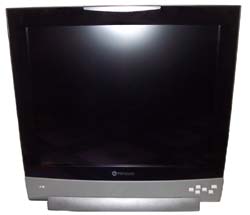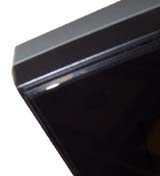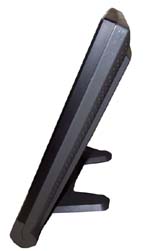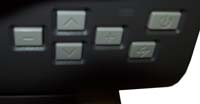
Original Link: https://www.anandtech.com/show/1006
Introduction
Several weeks ago we brought the first LCD monitor review to AnandTech. This week we have another high end LCD that pushes the boundary for innovation, but again with a high price tag.
This week, we are pleased to bring to you the AG Neovo S-18 LCD. Ever since the press release of this monitor was first given to us we had anxiously been awaiting one for review, eager to put the S-18 through the AnandTech monitor tests (which have been updated from our previous monitor reviews to include even more details on the monitor’s image).
This high end LCD has a strong overseas market, but is looking to compete strong in the US as well. Does Neovo have what it takes to bring solid competition to NEC, Samsung, and Hitachi? Let us find out in this weeks monitor review!
Construction:
Many Americans might not immediately recognize AG Neovo, but most likely our European and Asia Pacific readers do. AG Neovo has been around since 1992 as a high end manufacturer based in Taiwan. Of course today, there is also a European and a North American branch as well.
An important feature in a monitor is the overall presentation. Surprisingly, every so often, a monitor will have distracting diodes or unusually reflective writing on the front of the monitor. We were pleased to see the S-18 did not break this very basic of requirements. In fact, the S-18 demonstrates a very simple and stylish appearance. (The ‘S’ in S-18 denotes Neovo’s “stylish” model.)
Perhaps the most visually stunning aspect of the S-18 is the sleek black bezel. When the monitor is off, one almost gets a feeling of staring into the monolith from 2001: A Space Odyssey. Closer inspection revels that this sleekness comes from a fairly thick piece of glass Neovo calls a “NeoV Crystal Optic Filter.” The unique Filter creates an elegant first impression. Most of our other monitors at the AnandTech lab appear slightly ‘flimsy’ when next to the S-18. We will explain more about the NeoV Filter in detail after analyzing the exterior construction of the monitor.
Even though the simplistic design is fairly impressive, there is more to a monitor than sleek design. We stressed in the last review that pixel quality holds an enormous amount of importance. As we expect from a review model, there were zero defects in the LCD. Occasionally, when buying an LCD monitor, several stuck pixels may be present. Some manufacturers allow up to a certain number of defective pixels per monitor in order to pass its quality test. However, since AG Neovo only produces LCD monitors exclusively, they have strict quality checks and tests. We would expect every monitor from AG Neovo to be of only the highest quality. From our experience, any retail store will take back a monitor with broken pixels and exchange it for a new monitor. Unfortunately, when buying an LCD online, you will have to pay for shipping to return the monitor to the online dealer.
Another key importance in choosing an LCD monitor is the response time. LCD’s do not have a genuine “refresh rate” per say. In fact, the response time is a more accurate representation of pixel redrawing. The S-18 boasts response times of 20ms (rise) and 30ms (fall). This means that the pixel takes 20ms to turn on (rise) and 30ms to turn off (fall). By most standards, anything under 30ms happens to be a very good response time. Since gamers require fast paced screen redraws, the lower the response time the better. If the response time is extremely low, the pixel is able to turn on (and turn off) more times per second; giving more fluid motion to an image without leaving a nasty looking ghost image behind. Casual users probably will not notice a difference in the picture quality while typing a word document on a monitor with a 35ms response time.
At 17.6lbs, the monitor is a little heavy. The extra weight is obviously due to the extra glass panel over the front of the bezel (the NeoV Filter). On the other hand, the S-18 provides a fairly shallow base, at 8.2”. This base has the ability to fold up vertical for a wall mounting. When the base is folded up, the total depth is under 4 inches. Unfortunately, the wall mounting kit is not included with the monitor.
|
AG Neovo S-18 |
|

|
|
|
LCD |
18” TFT LCD (Active Matrix) pixel pitch: 0.2805mm (H/V) NeoV Crystal Optic Filter |
|
Scanning Frequency |
Horizontal: 30-80kHz |
|
Response Time |
20ms / 30ms (Typical) |
|
Contrast Ratio |
300:1 (Typical) |
|
Compatibility |
1280 x 1024 (Native) |
|
Dimensions (WxHxD) |
16.4" x 17.7" x 8.2" |
|
Power |
Working : 48W Max Standby/Off: 5W |
|
Weight |
17.6 lbs |
|
Warranty |
3 years parts and labor |
NeoV Crystal Optic Filter
One thing we noticed the other day in the lab was how few monitors have a piece of glass over the screen. Most have the LCD screen exposed to the outside, protected by only a very thin sheath.
The S-18 (and most every AG Neovo LCD) has a patented ‘NeoV Crystal Optic Filter’ over the LCD and bezel of the monitor. The purpose of this 2.8mm Filter is threefold. First of all, it protects the screen itself. LCD screens themselves are incredibly vulnerable and unprotected. By even lightly pressing on a calculator screen you can damage the liquid crystal and possibly crack it. Monitors, of course, are no exception. We especially like the piece of mind the scratch-resistant glass provides.
As we mentioned, the purpose of the Optic Filter was threefold. Each side of the glass is triple coated with a polymer that filters intermediate wavelengths outside of the visible light spectrum. The S-18 datasheet claims this allows for the crispest colors possible giving the S-18 a slight edge in color definition. Of course, we will just have to confirm this ourselves!
The final purpose of the NeoV Filter is to provide an antireflective surface in front of the LCD. Surprisingly little reflection can be noticed while sitting in front of the LCD; much less than that of a CRT monitor. The very small amount of reflection appears to have a dark maroon haze.
Features
The construction of the S-18 has been quite acceptable, but do its features stack up as well?
The Samsung 191T and other high end LCD’s all ship with multiple inputs. Every high quality LCD display on the market has at least one 29-Pin DVI-D input. The S-18 is no exception. Neovo goes the extra mile to not only provide a 15-Pin D-Sub Analog input, but a 4-Pin S-Video and RCA CVBS input as well. Power users and gamers would only find use the DVI-D input for everyday use, but the S-Video and RCA inputs provide a clean and easy way to watch TV on the monitor itself! However, the S-Video/RCA input is shared; this means there are only three total unique inputs.
Power consumption on the S-18 appears to be fairly high for an LCD, but still low compared to a CRT monitor. At 48 watts, the AG Neovo consumes approximately half the electricity a 19” CRT monitor does. A typical 19” LCD on the market today consumes around 30W to 40W of electricity. Curiously, our S-18 came with a European 220V plug. The adaptor itself had a universal 3 prong input, so we simply replaced the 220V plug with a standard 110V AC 3 prong plug.
We briefly mentioned the wall and arm mountings. AG Neovo sells wall and gas-spring suspension kits to mount the LCD on. Medical environments would most benefit from these features, but buyers who are also short on desk space could also benefit from mounting their monitor. The tilting base of the monitor provides more than just a horizontal or vertical setting as well. There is a locking mechanism on the base that allows the monitor to be tilted up to 25 degrees without collapsing on itself.
OnScreen Display
While the S-18 does not posses the simplest menu we have seen, it provides all the functionality required. After playing with the controls for a few minutes, we were able to achieve all of the results we hoped to acquire.
By far, the most useful function is the “Auto” configuration. With (usually) only one touch, monitor properties were automatically adjusted to the most optimal configuration. As noted with the Samsung 191T, this process is not perfect. Occasionally, after pressing the “auto” button, our results would be horribly inaccurate (the screen will shift more than an inch off to the side). However, a second or third try at it seems to correct this problem.
The menu itself is broken up into five major categories; display adjust, color temperature, OSD (On Screen Display) adjust, input select, and misc adjust. Each category contains 4 to 8 items which can be modified with the 4 control buttons. To add to confusion however, the “Auto” button behaves as the “select” button as well. While running DisplayMate to configure our S-18, we spent more time scrolling through the OSD than actually running the benchmarks.
Unfortunately, to switch inputs was FIVE to SEVEN button combinations in the menu. For most people, this is acceptable. However, users who may want to use the S-18 to switch back and forth between video modes may be in for a slight surprise. Certainly, there are other, more important features on a monitor, but we were somewhat disappointed in the lack of user friendliness in the OSD. Hopefully, further revisions of the S series monitors will have an improved user interface.
The Test
For comparison purposes, we ran a combination of CheckScreen and DisplayMate on the AG Neovo S-18 against the previously reviewed Samsung 191T LCD. Below is a table with the tests performed and notes we made during testing. Our test machine is composed of an Inno3D GeForce4 4200 using DVI. We ran all of the tests at 1280x1024 pixels with a refresh rate of 60Hz.
| DisplayMate/CheckScreen |
||
| Test |
Monitor |
Observations |
| Intensity range check |
S-18 |
Looks good |
| 191T |
Looks good |
|
| Black level adjustment |
S-18 |
Very bright darks. |
| 191T |
Blacks appear slightly lighter than on CRT |
|
| Defocusing, blooming and halos check |
S-18 |
None |
| 191T |
None |
|
| Screen uniformity and color purity |
S-18 |
Complete uniformity |
| 191T |
Sharp, crisp, pure |
|
| Dark screen |
S-18 |
Dark maroon glare, less than a CRT |
| 191T |
Very little glare. Anti-reflective screen |
|
| Primary colors |
S-18 |
Colors appear a little cool |
| 191T |
Looks good |
|
| Color Scales |
S-18 |
Reds darken too fast. |
| 191T |
Reds got dark a little too fast |
|
| 16 intensity levels |
S-18 |
Blue/Green appears to slight mis-register. |
| 191T |
Looks good |
|
| Pincushion/barrel distortion |
S-18 |
No distortion. |
| 191T |
Completely straight, no distortion |
|
| Geometric Linearity |
S-18 |
Completely flat, no distortion |
| 191T |
Razor sharp grid, no curvature |
|
| Focus check |
S-18 |
Focus on edges is the same as in the middle. |
| 191T |
Uniform clean focus |
|
| Horizontal color registration |
S-18 |
None |
| 191T |
Slightly off on each color, expected due to RGB sub pixels |
|
| Vertical color registration |
S-18 |
Slight offset, common LCD problem |
| 191T |
Completely level |
|
| Fine line moiré pattern |
S-18 |
No ripples, No waves. |
| 191T |
Vertical Moiré, corrected slightly by controls |
|
| Screen regulation |
S-18 |
No distortion |
| 191T |
No problems |
|
| Streaking and ghosting |
S-18 |
Very subtle streaking. |
| 191T |
Intense streaking over grey. Very surprised to see! |
|
From our tests we can see that the AG Neovo S-18 has very few problems with our custom benchmark suite. The only real disappointments we had were with the monitors fairly light shades of black. As we pointed out in our last review, LCD monitors have difficulty reproducing black because the backlight must be constantly on. On the contrary, CRT monitors simply dim the electron beam as to where the black areas are necessary. Unfortunately for LCD monitors, there is no set standard for determining contrast ratios. Look forward to seeing a contrast test from AnandTech sometime in the future!
We noticed the cool colors (blue, purple, etc) slightly mis-registered. Furthermore, the reds tended to darken slightly faster than they should have. When we analyzed the colors closely, there was a general feeling that the NeoV filter was actually skewing the colors a little. This is most likely due to the slight tinting within the filter to dull any reflection. Graphic designers who plan on investing in an S-18 may end up spending a fair bit of time tweaking the factory standard colors!
Conclusions
There were a lot of things we liked about the S-18. We were very pleased with the NeoV filter, even though it may have been the cause of some slight color misrepresentation. However, the extra piece of glass in front of the LCD screen was certainly an innovative and we would like to see more manufacturers ship LCD’s with a similar option. While the S-18 carries a suggested street price of $1099, we were able to find it online for under $1000. While this may be slightly pricey for many, compared to several other 18” LCD’s on the market, the S-18 is very reasonably priced.
The image quality of the monitor provided us with enough satisfaction to use the monitor for gaming instead of a CRT. However, programmers other professionals whose jobs require spending long hours in front of a monitor will be happy to know the S-18 performs very well for everyday use. We were slightly disappointed with the OSD, however we would only expect AG Neovo to continue improving their user interface. Overall, we consider the AG Neovo S-18 an excellent buy for the money, especially if you can get one for under $1000.
The S-18 proves itself a high quality display, with very few flaws. Both the Samsung 191T and the AG Neovo S-18 demonstrate the qualities we desired for monitors of their caliber, however we notices several differences. The 191T (with no protective bezel) seems to perform better in the field of text processing while the image on the S-18 provided a slightly better platform for graphical development (and games). While both had minor streaking issues, the champion for graphics appears to be the S-18. However, keep in mind the S-18 is slightly smaller than the 191T (18.1 viewable vs 19.0 viewable).
As we continue to see LCD’s evolve and drop in price, we have to constantly keep on our toes. As we see more and more LCD’s on the market, surely we will see new features and improvements that may just be the next best thing!















